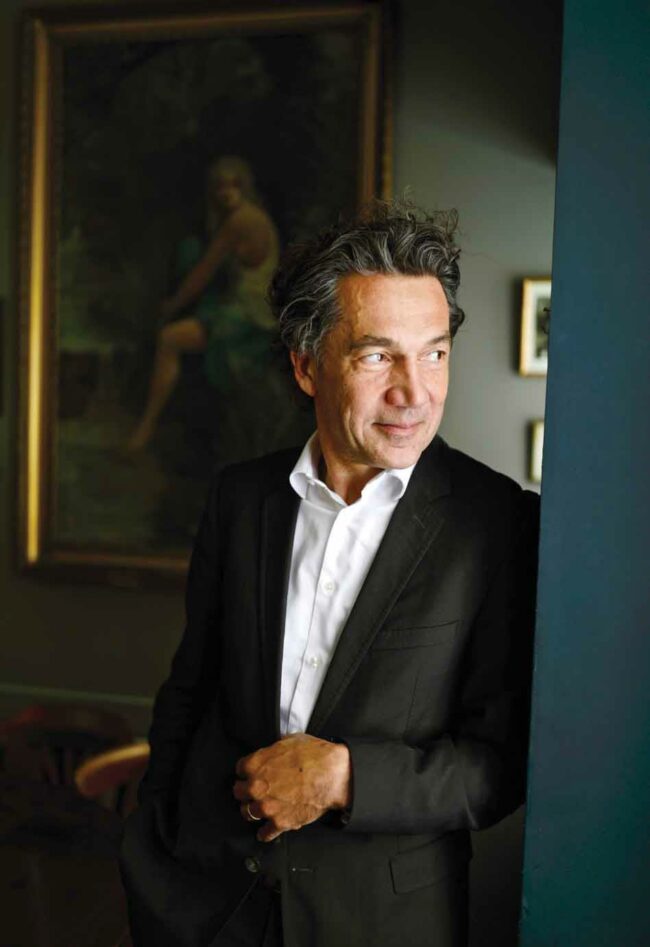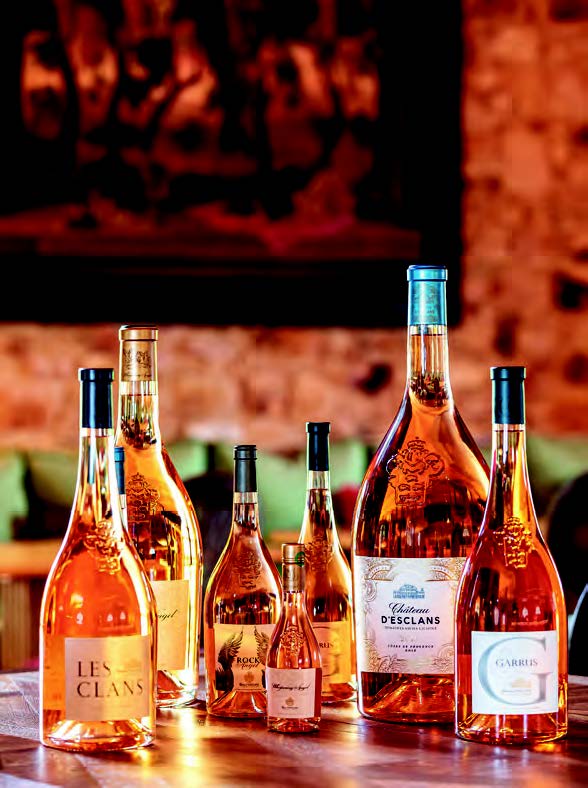by Françoise Parguel
🔓 This article is in free access for all.
Extracts from the book La saga des grands rosés de Provence (éditions de La Martinière). Never before has a book looked so closely at the fantastic history of Provence rosé. Our colleague’s book tells the story of how the colour changed the face of this vineyard, that has now become the one that everyone is watching.
WE KNOW THE idyllic, authentic, almost hidden PROVENCE. But there’s also the noisier, more blinged-out Provence. From west to east, Arles, the Sainte-Victoire, Aix-en-Provence, the Luberon, the Maures massif, the Esterel and its red rocks. To the south, the coastline, the capes, the amethyst-filled coves, the islands and peninsulas, the French Riviera, Cannes and Nice. Everyone has their own geographical definition, often based on their own memories or imagination. But who cares about its real borders? For many, it will always be a must. A destination. Sunshine, unique light, sublime landscapes, fields of lavender, century-old olive trees and maritime pines, cicadas, hilltop villages, architectural remains and the infinite blue of the sky plunging into the Mediterranean. The charm of the art of living in Provence. Pagnol, Daudet, Mistral, Giono and Rostand have written about it, and Impressionists and Fauves have painted it. Cézanne, a child of the region, magnified it. Fleeing a prohibitionist and corseted America, Gertrude Stein, Ernest Hemingway, Pablo Picasso and Cole Porter, led by Zelda and Scott Fitzgerald, launched the Côte d’Azur fashion in summer at the Villa Saint-Louis on Cap d’Antibes: the faithful shadows of Tendre est la nuit crept into the glamour of the Roaring Twenties. Since then, the Americans have adopted it. Cannes launched its Festival. A certain Roger Vadim created Brigitte Bardot in the little harbour of Saint-Tropez. Club 55 inaugurated the beaches of Pampelonne. Princess Grace Kelly became part of the legend. A few Parisians followed Sagan along the plane-tree-lined N7 towards the South of France. Goodbye, sadness. Tourism took hold and, since then, the whole of Provence has been loved. After this uninterrupted international promotion by great artists, influencers before their time, the new craze for this mythical region comes from its rosé wines.
LA VIE EN ROSE Who could have imagined, at the dawn of the second millennium, that rosés from Provence would experience such a surge in popularity, going from a pleasant little summer wine, drowned in ice cubes between pétanque and barbecue, to a revolution on the palate. A pale colour that has become a world standard. The birth of a wine category in its own right, with the luxury of challenging the eternal red-white duo. What a wonderful story for this land of Provence which, over the generations, has been able to showcase the diversity of its terroirs and impose its aromatic white wines and typical reds for ageing. Provence is France’s oldest wine-growing region, with 2,600 years of history. Today, its rosé wines are at the top of the world rankings. A wine without complexe, often simple but increasingly sincere, rosé has been imposed by consumers. No rules, no dogma. Very accessible, with an elegant colour, its primary aroma is conviviality. Festive, it has its moments: as an aperitif, with a meal, as an accompaniment to all types of cuisine and even on the grandest of tables. Women have embraced it, and millennials from all over the world are now posting it on Instagram. Rosé all day and all night on the private beaches of the Côte d’Azur, Ibiza, Mykonos, Porto Cervo, Miami, Dubai and so on. No other French wine-growing region has experienced such growth in such a short space of time, and with such success. In less than forty years, Provence has taken rosé wine by storm. Alongside the great founding families – the Otts, the Farnet-Mattons, the Sumeires – and passionate winegrowers, it has attracted to its vineyards a cohort of very wealthy entrepreneurs who quickly became enthusiasts, and visionaries like Sacha Lichine. This has been followed by major wine and spirits groups such as Pernod Ricard and Roederer, and luxury groups such as LVMH and Chanel, watchmaker Richard Mille, actor Brad Pitt, a British Lord and many others.
THE ROAD AHEAD Surfing on sustained growth and a well-established international reputation, Provence rosé wines are still on a roll. The arrival of major groups and wealthy investors has given the region a new face and boosted its dynamism. Progress in quality in the vineyards, perfect technical mastery in the cellars and a glamorous name are the major, solid assets of rosé wine. This does not rule out a number of challenges: maintaining the region’s leading position and managing inflation in land and market prices, while finding the right environmental equation and adapting to climate change. Recent history has shown that a slowdown in activity linked to a pandemic, protectionism on the part of certain countries and an economic crisis can suddenly have an impact on development. And on the natural side, frost, drought and hail are risks that can reduce production every year. These are all climatic and economic variables that need to be anticipated, even when the weather is fine, both in the vineyards and on the markets. One of the key issues remains the ability of Provence rosé wines to maintain their leadership, especially on the international market where they are now highly prized. Without abandoning the domestic market by positioning them too elitistly, opening wide the door to other regions.
THE NAME THAT MAKES PEOPLE DREAM AND SELL In many, many countries, buying a bottle of rosé from Provence means savouring its art de vivre. Having established itself as the leading vineyard specialising in rosé wines, Provence is determined to maintain this competitive advantage and remain the driving force behind the rosé train. Consolidated figures show that all production is sold, so to keep pace with soaring markets, meeting demand is a priority. With demand outstripping supply, scarcity sets in and selling prices rise: markets are looking elsewhere for rosé wines. On the vineyard side, there are two levers: enlarge the appellation area by granting substantial planting rights, and authorise higher yields when the vintage allows, but without compromising quality. These solutions are in the hands of the professional authorities and have been called for by certain players. As far as extending the appellation is concerned, the challenge seems to be to find production areas. When it comes to yields, nature often dictates. It is certain that the Californians and Chileans, who are already starting to produce rosé, will not take years to find the qualitative martingale and launch their own brands. It’s a game they’ve mastered. And the Languedoc region is already well established. After converting the United States to rosé wine, Sacha Lichine admits to conducting a few trials to produce rosé wine in California, near Santa Barbara. The name has already been found: Whispering Angels… While meeting demand is the key to staying on the top step of the podium, promoting the region, with a focus on the word Provence and the appellation, is a priority for the Conseil Interprofessionnel des Vins de Provence (CIVP). In addition, an application to have the rosé wines of Provence recognised as part of UNESCO’s intangible heritage is currently being studied.
TOWARDS ORGANIC AND HVE (High Environmental Value) VINEYARDS IN 2030 On the French market, the challenges are identical, with a need to rebalance exports. The domestic market, where volumes are sold through supermarkets, remains an important outlet for many wine merchants and producers, who sell some of their wines there. Since 2018, export sales have exceeded sales to French supermarkets, and the trend is continuing. The Languedoc, which already has a strong presence in the region, has many assets to offer: Mediterranean grape varieties, climate, expertise, diversity of appellations and the dynamism of many operators. The Pays-d’Oc IGP is also the world’s leading producer of rosé wine (non-AOC), and conversion to organic farming is well advanced in its vineyards, the largest in France. On this point, the Provencal wine industry is stepping up the pace with ‘EnViProv’, a bold project launched in early 2022 and supported by the CIVP. Its aims are to get all the players involved to reduce their environmental impact (particularly carbon) while maintaining the quality of their wines, to achieve collective High Environmental Value (HVE) or organic certification for the entire vineyard by 2030, and to make virtuous practices widespread in both the vineyard and the cellar. It’s a bold move, certainly, with over 50% of the region already certified organic or HVE, but one that still needs to convince some who are reluctant to take the plunge, not least because of the financial impact. The quest for this agro-ecological transition also involves work by the Centre du rosé on grape varieties that are resistant to vine diseases – which would no longer require treatment – and to drought, in order to combat global warming. ON
THE CHAMPAGNE ROUTE Rosé wines from Provence borrow their codes from Champagne, with strong brands and prestigious cuvées already commanding stratospheric prices. Although not in the same category, the two wines nevertheless share a number of similarities: festive consumption, the power of the imaginary name, conviviality, the specificity of the bubbles for one and the pale pink colour that has become a standard for the other. Two distinct identities. Centuries of history no doubt still make the difference. The fact remains that Provence, France’s oldest wine-growing region, has been making rosé wine for ages, even if its revolution, which has enabled it to pre-empt rosé wine on the world stage, dates back barely forty years. In 2022, for the first time, sales of Champagne in France will fall in favour of exports: more Champagne is now drunk abroad than in France. Is the same true for rosé wines from Provence? Not yet in terms of volume, but the trend is reversing, with a real strategy to raise the profile of our wines, reflected in a booming export market. More than ever, the region is capitalising on its name to claim world leadership in great rosé wines. The arrival of major wine and spirits groups, Champagne producers, the luxury sector and investors is a clear demonstration of the popularity of the colour rosé and the predominance of Provence. Once again, know-how, tradition, symbolism, imagination and adaptation will be the key words for the longevity of this success. Our ambition is for Provence to be to rosé wines what Champagne is to bubbly wines.
THE RIGHT BALANCE Like other regions before it, Provence is paying the price for its success: inflation in the price of classified land, which today limits acquisitions to the very wealthy. Without reaching the heights of the great growths of Bordeaux, Burgundy or Champagne, the price per hectare has risen exponentially in less than twenty years. The average is between €100,000 and €150,000 per hectare, with record prices in the Var and along the coast. That’s two to three times the price per hectare in five years. Beneficial to the owners, this increase in the value of the land is beginning to be a handicap for successions and the installation of young winegrowers. The price of bulk wine in the Côtes-de-Provence appellation, the benchmark for supplies to wine merchants and cooperatives, has risen from 140 euros/hl per hectare to 300 euros/hl in fifteen years. This is a blessing for winegrowers without estates, and inflation for the wine merchants. As with its wines, Provence needs to find the right balance. Between large estates, international brands and small estates. Protecting AOCs and the Provence brand is an essential step, a guarantee of the region’s history and expertise. A wine for every occasion, for aperitifs, meals and evenings out, and now drunk in all seasons, Provence rosé has quickly won over new generations, imposing its style and colour. Even at premium prices. Daring, passion, innovation, quality and diversity are just some of the hallmarks of its continued phenomenal success around the world.
























